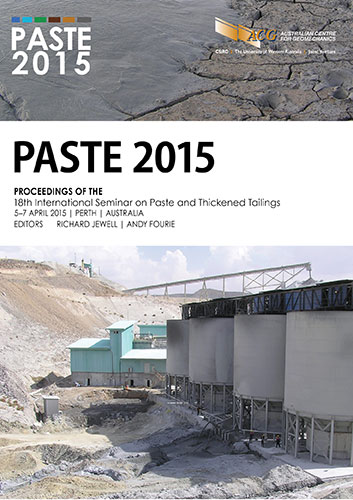Stress analysis of underground pipelines with flexible couplings – unrestrained approach

|
Authors: Sabeti, J; Asgarian, A Paper is not available for download Contact Us |
DOI https://doi.org/10.36487/ACG_rep/1504_20_Sabeti
Cite As:
Sabeti, J & Asgarian, A 2015, 'Stress analysis of underground pipelines with flexible couplings – unrestrained approach', in R Jewell & AB Fourie (eds), Paste 2015: Proceedings of the 18th International Seminar on Paste and Thickened Tailings, Australian Centre for Geomechanics, Perth, pp. 277-289, https://doi.org/10.36487/ACG_rep/1504_20_Sabeti
Abstract:
The application of grooved couplings in underground paste pipelines is increasing as the mines go deeper and the pressure in the pipeline systems gets higher. This type of connection offers fast installation, convenient maintenance, and allows for easier rotation of the paste backfill pipelines. There are two common types of grooved couplings with different applications: rigid and flexible. Rigid couplings utilise a single groove on each side of the connection to hold the line together, and are normally used in paste backfill pipelines with low pressure. Rigid couplings provide a rigid joint that allows no angular deflection or linear movement and in that are similar to traditional flanged, welded, or threaded connections. For extra high-pressure paste pipeline applications (above 10 MPa for a DN 200, Sch 120 pipeline), double grooved (flexible) couplings are utilised. The design of this type of coupling introduces some level of flexibility to the system (higher degree of angular movement and axial displacement). Despite the several advantages that flexible couplings introduce to a piping system, stress analysis and support design for this type of connection are much more complicated than for traditional rigid joints. In this article, we present the complexities that were faced in the stress analysis and design of supports for a high-pressure underground paste pipeline with flexible connections. The practical design approach for this application will be introduced as well. The understudied paste backfill pipeline has some characteristics that make it a challenging subject for flexibility and stress analysis. These characteristics include high operating/design pressures; use of high-pressure flexible couplings for pipe connections; physical properties of the pipeline such as the slope of the pipeline in the ramp, and the relatively high temperature differences between installation and operating conditions. A detailed stress analysis using the ‘unrestrained design approach’ (see Section 4.2) was performed in the course of the project to achieve acceptable pipe stress and support loads of the system. The calculation results showed some specific requirements for installation of double grooved flexible couplings. These requirements include installation of the couplings with a specified gap, use of natural bends and expansion loops to compensate for the expansion and contraction of the system, and the design of line stop points at specified intervals to distribute the expansion and contraction of the system.
References:
American Society of Mechanical Engineering 2012, ASME B31.4: Pipeline Transportation Systems for Liquids and Slurries, ASME, New York.
American Society of Mechanical Engineering 2002, ASME B31.11: Slurry Transportation Piping Systems, ASME, New York.
ASTM International 2011, ASTM A106/A106M: Standard Specification for Seamless Carbon Steel Pipe for High-Temperature Service, ASTM International, West Conshohocken.
Bentley Systems, Inc. 2007, Bentley AutoPIPE User XM Edition, Bentley Systems, Inc., Exton.
Bentley Systems, Inc. 2013, Bentley Systems, Inc., Exton, viewed 11 March 2014, communities.bentley.com/products/
pipe_stress_analysis/w/pipe_stress_analysis__wiki/9121.k-victaulic-fittings-modeling-approaches-tips-techniques-used-in-autopipe
Hyspan Precision Products, Inc.1986, Hyspan Technical Notes, Hyspan, CA.
Intergraph CADWorx & Analysis Solutions 1998, Pipe Stress Analysis Seminar Notes, Intergraph CADWorx & Analysis Solutions, USA.
Pearson, KT 2011, Applying ASME Code B31.11 Slurry Transportation Piping Systems, An ANSI Standard, The Sothern African Institute of Mining and Metallurgy, Johannesburg.
Sabeti, J 2011, ‘Underground paste backfill pipeline support design, applying ASME code B31.11’, Proceedings of the 5th International Industry Summit on Mining Performance, Society for Mining, Metallurgy and Exploration, Englewood.
Walsh, D n.d., Considerations for the hanging or supporting of grooved piping systems, Anvil International, Inc., Exeter, viewed 15 March 2015,
© Copyright 2025, Australian Centre for Geomechanics (ACG), The University of Western Australia. All rights reserved.
View copyright/legal information
Please direct any queries or error reports to repository-acg@uwa.edu.au
View copyright/legal information
Please direct any queries or error reports to repository-acg@uwa.edu.au